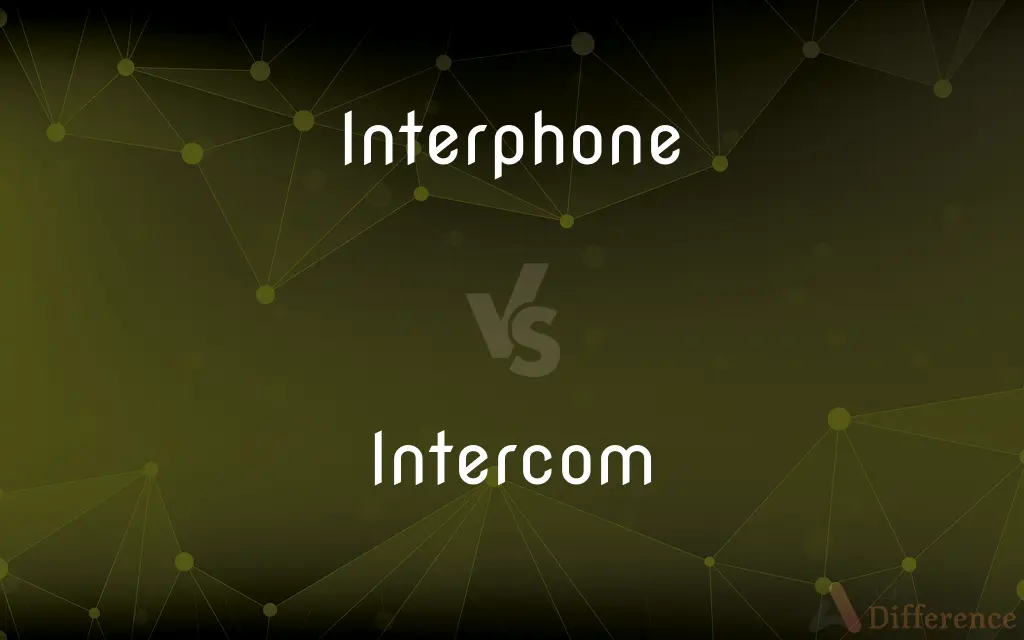Interphone vs. Intercom — What's the Difference?
By Urooj Arif & Fiza Rafique — Updated on March 25, 2024
An interphone is a device for direct voice communication within a limited area, often used in vehicles or specific locations, whereas an intercom is a system that allows communication across multiple stations within a building or complex.

Difference Between Interphone and Intercom
Table of Contents
ADVERTISEMENT
Key Differences
An interphone system is designed for direct, two-way voice communication, typically used within a confined area such as within vehicles, aircraft, and specific points in a building or facility. It is often utilized in environments where immediate and clear communication is crucial, such as between the cockpit and cabin crew in an airplane. Interphones facilitate quick and efficient exchange of information without the need for a complex network. On the other hand, an intercom (intercommunication device) is a more extensive communication system that enables individuals to speak with one another from different rooms or areas within a building or a complex. Intercom systems can range from simple, one-way devices to sophisticated, multi-channel systems that include features like video communication, public address capabilities, and external telephone integration.
While interphone systems are typically hardwired and dedicated to specific communication points, intercom systems can be both wired and wireless, offering more flexibility in terms of installation and usage. Intercoms are widely used in residential, commercial, and institutional settings, providing a versatile solution for internal communication needs. They allow for announcements, two-way conversations, and in some cases, monitoring and access control, such as in entry systems for buildings.
The operational range of an interphone is generally limited to the specific area or vehicle it serves, focusing on direct, point-to-point communication. This limitation is by design, ensuring that communication is restricted to relevant parties within a controlled environment. Conversely, intercom systems are designed to cover larger areas, with the ability to link multiple stations or units across different locations within a site, offering both selective and group communication options.
In terms of functionality, interphones are often specialized for the environments they are used in, with features tailored to specific operational requirements, such as noise cancellation in aircraft interphones. Intercom systems, however, offer a broader range of functionalities to accommodate different communication needs, from basic voice communication to integrated video, security, and even entertainment functions in advanced models.
Despite their differences, both interphone and intercom systems serve the fundamental purpose of facilitating communication where direct conversation is not possible due to distance or environmental barriers. They enhance coordination, safety, and efficiency in various settings, from facilitating pilot-cabin crew communication in flights to enabling residents to grant entry to visitors from the security of their homes.
ADVERTISEMENT
Comparison Chart
Definition
Device for direct voice communication within a limited area.
System that allows communication across multiple stations within a complex.
Usage Context
Vehicles, aircraft, specific locations.
Buildings, residential complexes, offices.
Connectivity
Typically hardwired, point-to-point.
Wired and wireless, flexible installation.
Operational Range
Limited to specific area or vehicle.
Covers larger areas, multiple locations.
Functionality
Specialized features for specific environments.
Broad range of functions, including voice, video, and security.
Compare with Definitions
Interphone
Direct, Two-Way Voice.
An interphone facilitates immediate exchange of information without external inputs.
Intercom
Broad Functionality.
Advanced intercom systems integrate voice, video, security, and even entertainment.
Interphone
Focused Use.
Interphones are integral for direct communication in vehicles and specific parts of buildings.
Intercom
Wide Operational Range.
Designed to cover extensive areas, intercoms can link multiple units across a site.
Interphone
Confined Area Communication.
Interphones allow pilots to communicate with cabin crew in an aircraft.
Intercom
Versatile Installation.
Intercom systems can be both wired and wireless, suitable for various settings.
Interphone
Specialized Features.
Aircraft interphones include noise-canceling features for clear communication.
Intercom
Multiple Station Communication.
Intercoms enable speaking across different rooms or areas within a building.
Interphone
Hardwired System.
Most interphones are hardwired to ensure reliable communication in critical areas.
Intercom
Residential and Commercial Use.
Intercoms are used in homes, offices, and institutions for versatile communication needs.
Interphone
A telephone used in a small closed system of telephones
"The sergeant lifted the interphone and told the pilot that the door was properly sealed" (Tom Clancy).
Intercom
An intercom ("intercommunication device") or interphone is a stand-alone voice communications system for use within a building or small collection of buildings, functioning independently of the public telephone network. Intercoms are generally mounted permanently in buildings and vehicles.
Interphone
Intercom
Intercom
An electronic intercommunication system, as between two rooms.
Interphone
A telephonic intercommunication system linking different rooms in a building or ship etc
Intercom
An electronic communication system, especially one between rooms in a building.
Emergency intercom
Talk on the intercom
Intercom
(ambitransitive) To communicate (with) by intercom.
Intercom
A communication system linking different rooms within a building or ship etc
Common Curiosities
What is the main difference between an interphone and an intercom?
The main difference lies in their usage scope: interphones are for direct communication within a confined area, while intercoms facilitate broader communication across multiple stations.
Can interphone systems be used in residential buildings?
While typically used in vehicles and specific locations, interphones can be adapted for use in residential settings where direct, point-to-point communication is needed.
What features are important in an intercom system for a commercial property?
Important features may include multiple channels, video capability, integration with security and access control systems, and scalability for future expansion.
Can intercom systems be integrated with security systems?
Yes, many modern intercom systems offer integration with security systems, providing features like access control and surveillance.
Are all intercom systems capable of video communication?
Not all, but advanced intercom systems may include video capabilities, enhancing communication with visual support.
How do users choose between an interphone and an intercom system?
The choice depends on the communication needs: interphones for direct, limited-area communication, and intercoms for more extensive, multi-station communication.
Can intercoms be used for public address purposes?
Yes, many intercom systems include public address capabilities, allowing for announcements to be made to all or selected areas within a complex.
Is wireless connectivity reliable for intercom systems in large buildings?
Wireless intercom systems have advanced significantly, offering reliable connectivity options even in large buildings, though the specific reliability can depend on the system and building layout.
How do environmental factors affect the choice of an interphone system?
Environmental factors, such as noise levels and the need for waterproofing, can significantly influence the choice and features of interphone systems, especially in industrial or outdoor settings.
How has technology impacted the development of interphone and intercom systems?
Technological advancements have enhanced the functionality, reliability, and integration capabilities of both interphone and intercom systems, expanding their use and applications in various settings.
Share Your Discovery

Previous Comparison
Docent vs. Doctor
Next Comparison
Bramble vs. RoseAuthor Spotlight
Written by
Urooj ArifUrooj is a skilled content writer at Ask Difference, known for her exceptional ability to simplify complex topics into engaging and informative content. With a passion for research and a flair for clear, concise writing, she consistently delivers articles that resonate with our diverse audience.
Co-written by
Fiza RafiqueFiza Rafique is a skilled content writer at AskDifference.com, where she meticulously refines and enhances written pieces. Drawing from her vast editorial expertise, Fiza ensures clarity, accuracy, and precision in every article. Passionate about language, she continually seeks to elevate the quality of content for readers worldwide.













































